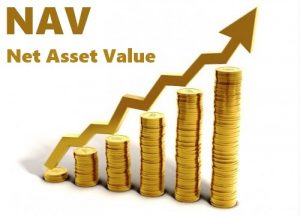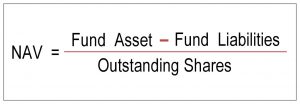Net asset value (NAV) stand for a fund’s per unit market value. This is the price at which investors buy the fund shares (number of units) from a fund company and sell them (redeem) to a fund company. The number of buying and selling units is important to investors because they are based upon the NAV – that is the price per unit. NAV is simply the price per share of the fund. Just like stocks have a share price; mutual funds have a Net Asset Value.
Investors must understand that redemption involves thorough research about the performance of the fund and clarity about the reasons for redemption. Decisions can go wrong when investors make such decisions based on sentiments and hearsay. If th e fund is underperforming, an impulse action is to redeem units. This is just not the right thing to do. Mutual funds are managed by professional fund managers who take proactive decisions and try to factor-in the perceived market movements. However, if a mutual fund scheme is time and again underperforming for a long period, one may choose to exit.
e fund is underperforming, an impulse action is to redeem units. This is just not the right thing to do. Mutual funds are managed by professional fund managers who take proactive decisions and try to factor-in the perceived market movements. However, if a mutual fund scheme is time and again underperforming for a long period, one may choose to exit.
NAV does not change throughout the day like share prices and thus, they get updated at the end of each trading day. NAV is calculated by dividing the total value of all the assets minus all its liabilities. It is calculated only at the end of every market day, after taking into account the closing market prices of the securities that the scheme or fund holds.
Remember this fact that for open-end mutual funds, NAV is a useful factor for tracing share price movements. However, it is not useful for assessing overall fund performance. This is because mutual funds are required by law to distribute at least 90% of their realized capital gains and dividend income to investors each year. When a fund pays investors the required allocation, its NAV reduces by the amount of the distribution. Therefore, investors should not track only NAV, as they may get concerned about the drop but in fact, the net value of their investment is unchanged. The reduction in NAV is counterbalanced by the amount of distribution they have been paid.
Open-ended fund is a scheme in which an investor can invest and redeem shares at any time. In contrast, a close-ended mutual fund typically has lock in period. For closed-end funds, share value is determined in the secondary markets, which are the formal exchanges, where the shares are traded. The NAV of a closed-end fund is the price per share multiplied by the total number of shares. Obviously, the value of a closed-end mutual fund changes continuously throughout the trading day and trading cycle.
The Current Value of Investment is the ‘Market Value’ of the Investment based on that day’s NAV of the Investment in the invested Scheme. It depends on the plan of the mutual fund. On all business, working days, depending on the scheme type, NAV is declared in the evening at or before 9 pm.
When you need to redeem your mutual fund:
If you have purchased mutual fund through an AMC (Asset Management Company) or Distributors, to redeem funds through offline modes, you need to send a duly signed redemption request to the AMC’s or the distributor’s office. A standard redemption form asks for details like your name, folio number, plan and scheme details, and number of units you wish to redeem. In addition, all the holders have to sign the slip. The proceeds from the redemption will be credited to the registered bank account.
In case of redemption if bought online, such units can be redeemed online through a trading account or the AMCs website. You simply have to log in, select the fund and the number of units you wish to redeem and confirm your order. Besides, online and offline, central service providers like CAMS (Computer Age Management Services Pvt. Ltd.), Karvy, etc. offer the option of redeeming mutual fund bought from several AMCs. You can download the form online or visit the nearest office. Please note that these agencies might not service all the AMCs.
These are few points you need to remember while redeeming:
Applicable NAV: the NAV will be applicable only for redemption requests received up to 3 pm on any day.
Time taken: Once the redemption request is effectively received and verified, it takes up to three working days for the proceeds to be credited to the registered bank account.
Investment in funds with Lock-In Period: Schemes like Equity Linked Savings Scheme (ELSS) cannot be redeemed up to 3 years from the date of investment. As an investor you must know what your investment advisor is investing on your behalf.
Exit Loads and Applicable Taxes: Based on the duration after which you are redeeming the funds, your transaction might attract certain amount of taxes and exit loads. Inquire about the same before finalizing a transaction. Some Asset Management Companies (AMCs) have sales charges, or loads, on their funds (entry load and/or exit load) to compensate for distribution costs. Funds that can be purchased without a sales charge are called no-load funds. Entry load is charged at the time an investor purchases the units of a scheme.
Author’s Advise: There are over 7,000 mutual funds, each with different goals and objectives. Some invest in bonds; some in stocks, some in index funds, and some in speciality so on and so forth. Some are balanced funds owning both bonds and stocks. Some are conservative, some are aggressive. Some are structured to produce dividends and interest income, others invest for growth.
A growth fund is a diversified portfolio of stocks that has capital appreciation as its primary goal, with little or no dividend payouts. The portfolio mainly consists of companies with above-average growth that reinvest their earnings into expansion, acquisitions and/or research and development.
As an investor it is better to understand the basic facts about the mutual funds. You need to pick a mutual fund that will be good returns on your investment while saving the principal amount. You need to define your investing goals and objectives. For example, if you’re not planning on using the funds for a long time, you can focus on long-term growth. If you don’t like risk or need to use the money in the next few years you will want to focus on safety. If you pick a growth fund, while you needed safety, you should know that the growth fund is vulnerable to market risks. Have a good financial advisor, who is your well-wisher first. Remember a basic fact, if you are redeeming from one scheme and investing into another scheme of the similar kind is called ‘churning’ and it is not advisable unless you are backed by sound knowledge and sound logic. Play safe because mutual fund investments are subject to market risks.















































